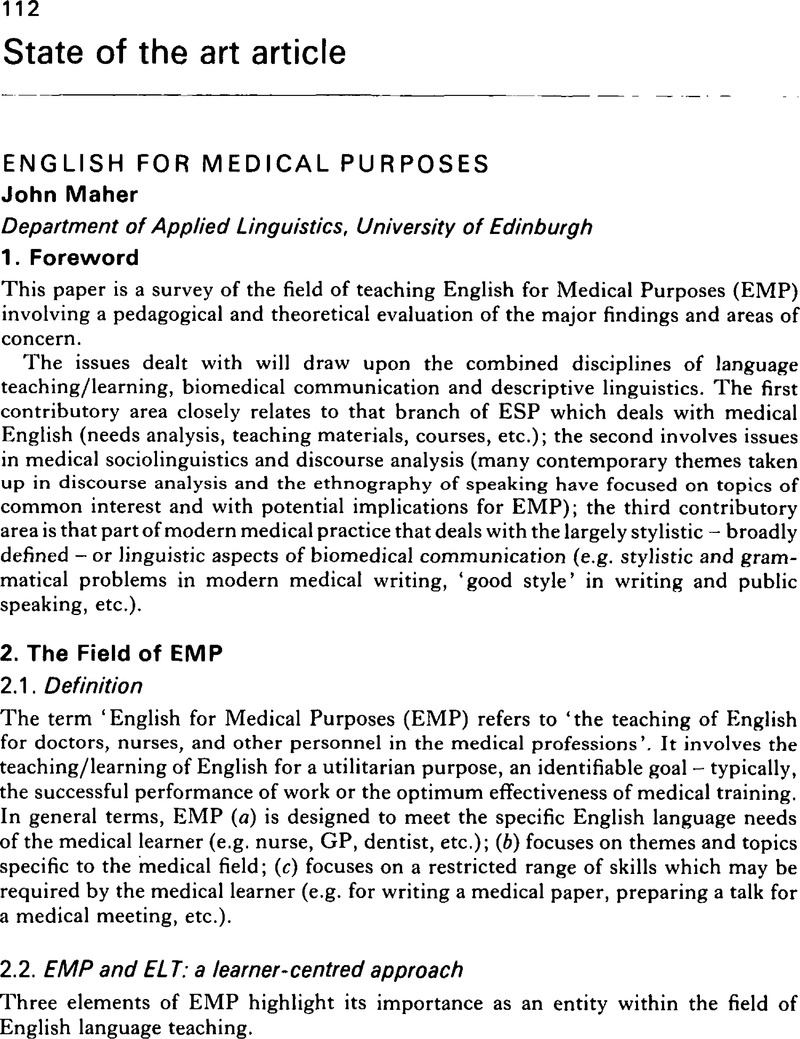Crossref Citations
This article has been cited by the following publications. This list is generated based on data provided by Crossref.
Kaplan, Robert B.
1986.
Introduction.
Annual Review of Applied Linguistics,
Vol. 7,
Issue. ,
p.
vii.
van Naerssen, Margaret
and
Kaplan, Robert B.
1986.
Language and Science.
Annual Review of Applied Linguistics,
Vol. 7,
Issue. ,
p.
86.
Swales, John
1987.
Communicative Language Teaching in ESP Contexts.
Annual Review of Applied Linguistics,
Vol. 8,
Issue. ,
p.
48.
Maher, J.
1987.
English as an international language of medicine.
Medical Education,
Vol. 21,
Issue. 4,
p.
283.
Parkinson, Brian
and
Maher, John
1987.
Communicative Language Teaching and Related Approaches.
Annual Review of Applied Linguistics,
Vol. 8,
Issue. ,
p.
126.
1989.
Working with Language.
p.
573.
Machauf, Liora
1990.
The language of civil engineering: Descriptive, prescriptive and persuasive.
Language Sciences,
Vol. 12,
Issue. 2-3,
p.
243.
Lowe, Ivan
1996.
Non-verbal devices in pre-university science: The extent of correspondence between English and French.
English for Specific Purposes,
Vol. 15,
Issue. 3,
p.
217.
Maher, John
1997.
Linguistic Minorities and Education in Japan.
Educational Review,
Vol. 49,
Issue. 2,
p.
115.
Guillén Galve, Ignacio
1998.
The textual interplay of grammatical metaphor on the nominalizations occurring in written medical English.
Journal of Pragmatics,
Vol. 30,
Issue. 3,
p.
363.
Macdonald, Malcolm N.
2002.
Pedagogy, pathology and ideology: the production, transmission and reproduction of medical discourse.
Discourse & Society,
Vol. 13,
Issue. 4,
p.
447.
Tipton, Sara M.
2011.
English Language and the Medical Profession: Instructing and Assessing the Communication Skills of International Physicians.
Vol. 5,
Issue. ,
p.
91.
2011.
English Language and the Medical Profession: Instructing and Assessing the Communication Skills of International Physicians.
Vol. 5,
Issue. ,
p.
291.
Hoekje, Barbara J.
2012.
The Encyclopedia of Applied Linguistics.
Franklin-Landi, Rebecca
2017.
New developments in ESP teaching and learning research.
p.
153.
이승연
신정하
and
심지연
2017.
A Genre Analysis of Newspaper Articles for Korean Language Education -Based on the linguistic analysis of newspaper articles and reading materials in Korean language textbooks-.
Journal of Korean Language Education,
Vol. 28,
Issue. 3,
p.
53.
Choi, Lee Jin
2021.
Implementing English for Medical Purposes (EMP) in South Korea: Nursing students' ongoing needs analysis.
Nurse Education Today,
Vol. 104,
Issue. ,
p.
104989.
Båge, Karin
Gaunt, Albin
and
Valcke, Jennifer
2021.
Aligning glocal agendas for international education.
European Journal of Language Policy,
Vol. 13,
Issue. 2,
p.
223.
DEMİR, Bora
and
HAMARAT, Bahattin
2022.
Development of a New Language Learning Motivation Scale for Medical Students.
İnsan ve Toplum Bilimleri Araştırmaları Dergisi,
Vol. 11,
Issue. 4,
p.
2289.
Liu, Jiajia
Cai, Jigang
Guo, Shufa
and
Yang, Xiumu
2023.
Improving Chinese nursing undergraduates’ nurse-patient clinical communication competence in English: A study based on a target situation needs analysis.
Heliyon,
Vol. 9,
Issue. 10,
p.
e20441.





